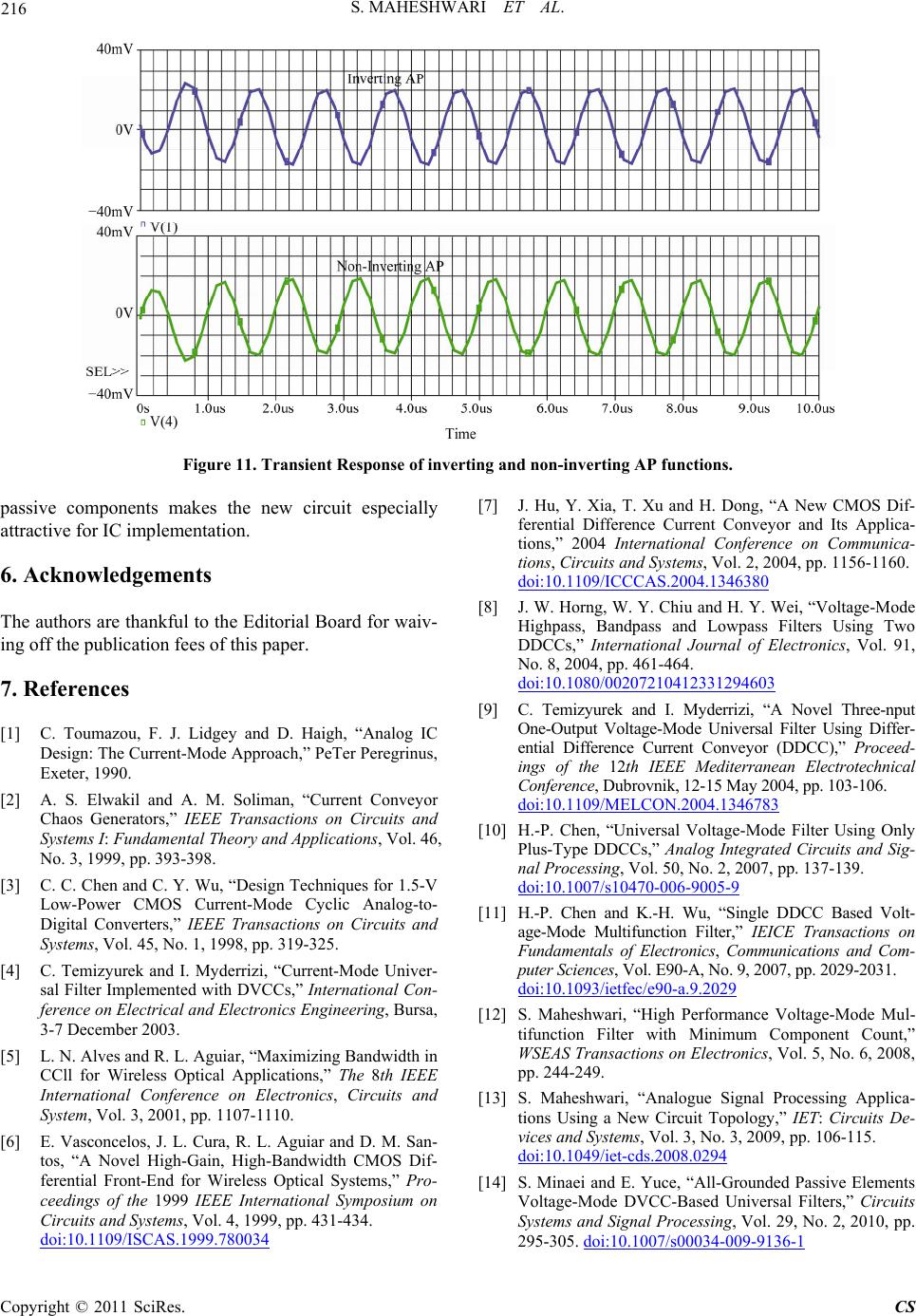
216 S. MAHESHWARI ET AL.
Figure 11. Transient Response of inverting and non-inverting AP functions.
passive components makes the new circuit especially
attractive for IC implementation.
6. Acknowledgements
The authors are thankful to the Editorial Board for waiv-
ing off the publication fees of this paper.
7. References
[1] C. Toumazou, F. J. Lidgey and D. Haigh, “Analog IC
Design: The Current-Mode Approach,” PeTer Peregrinus,
Exeter, 1990.
[2] A. S. Elwakil and A. M. Soliman, “Current Conveyor
Chaos Generators,” IEEE Transactions on Circuits and
Systems I: Fundamental Theory and Applications, Vol. 46,
No. 3, 1999, pp. 393-398.
[3] C. C. Chen and C. Y. Wu, “Design Techniques for 1.5-V
Low-Power CMOS Current-Mode Cyclic Analog-to-
Digital Converters,” IEEE Transactions on Circuits and
Systems, Vol. 45, No. 1, 1998, pp. 319-325.
[4] C. Temizyurek and I. Myderrizi, “Current-Mode Univer-
sal Filter Implemented with DVCCs,” International Con-
ference on Electrical and Electronics Engineering, Bursa,
3-7 December 2003.
[5] L. N. Alves and R. L. Aguiar, “Maximizing Bandwidth in
CCll for Wireless Optical Applications,” The 8th IEEE
International Conference on Electronics, Circuits and
System, Vol. 3, 2001, pp. 1107-1110.
[6] E. Vasconcelos, J. L. Cura, R. L. Aguiar and D. M. San-
tos, “A Novel High-Gain, High-Bandwidth CMOS Dif-
ferential Front-End for Wireless Optical Systems,” Pro-
ceedings of the 1999 IEEE International Symposium on
Circuits and Systems, Vol. 4, 1999, pp. 431-434.
doi:10.1109/ISCAS.1999.780034
[7] J. Hu, Y. Xia, T. Xu and H. Dong, “A New CMOS Dif-
ferential Difference Current Conveyor and Its Applica-
tions,” 2004 International Conference on Communica-
tions, Circuits and Systems, Vol. 2, 2004, pp. 1156-1160.
doi:10.1109/ICCCAS.2004.1346380
[8] J. W. Horng, W. Y. Chiu and H. Y. Wei, “Voltage-Mode
Highpass, Bandpass and Lowpass Filters Using Two
DDCCs,” International Journal of Electronics, Vol. 91,
o. 8, 2004, pp. 461-464.
doi:10.1080/00207210412331294603
[9] C. Temizyurek and I. Myderrizi, “A Novel Three-nput
One-Output Voltage-Mode Universal Filter Using Differ-
ential Difference Current Conveyor (DDCC),” Proceed-
ings of the 12th IEEE Mediterranean Electrotechnical
Conference, Dubrovnik, 12-15 May 2004, pp. 103-106.
doi:10.1109/MELCON.2004.1346783
[10] H.-P. Chen, “Universal Voltage-Mode Filter Using Only
Plus-Type DDCCs,” Analog Integrated Circuits and Sig-
nal Processing, Vol. 50, No. 2, 2007, pp. 137-139.
doi:10.1007/s10470-006-9005-9
[11] H.-P. Chen and K.-H. Wu, “Single DDCC Based Volt-
age-Mode Multifunction Filter,” IEICE Transactions on
Fundamentals of Electronics, Communications and Com-
puter Sciences, Vol. E90-A, No. 9, 2007, pp. 2029-2031.
doi:10.1093/ietfec/e90-a.9.2029
[12] S. Maheshwari, “High Performance Voltage-Mode Mul-
tifunction Filter with Minimum Component Count,”
WSEAS Transactions on Electronics, Vol. 5, No. 6, 2008,
pp. 244-249.
[13] S. Maheshwari, “Analogue Signal Processing Applica-
tions Using a New Circuit Topology,” IET: Circuits De-
vices and Systems, Vol. 3, No. 3, 2009, pp. 106-115.
doi:10.1049/iet-cds.2008.0294
[14] S. Minaei and E. Yuce, “All-Grounded Passive Elements
Voltage-Mode DVCC-Based Universal Filters,” Circuits
Systems and Signal Processing, Vol. 29, No. 2, 2010, pp.
295-305. doi:10.1007/s00034-009-9136-1
Copyright © 2011 SciRes. CS